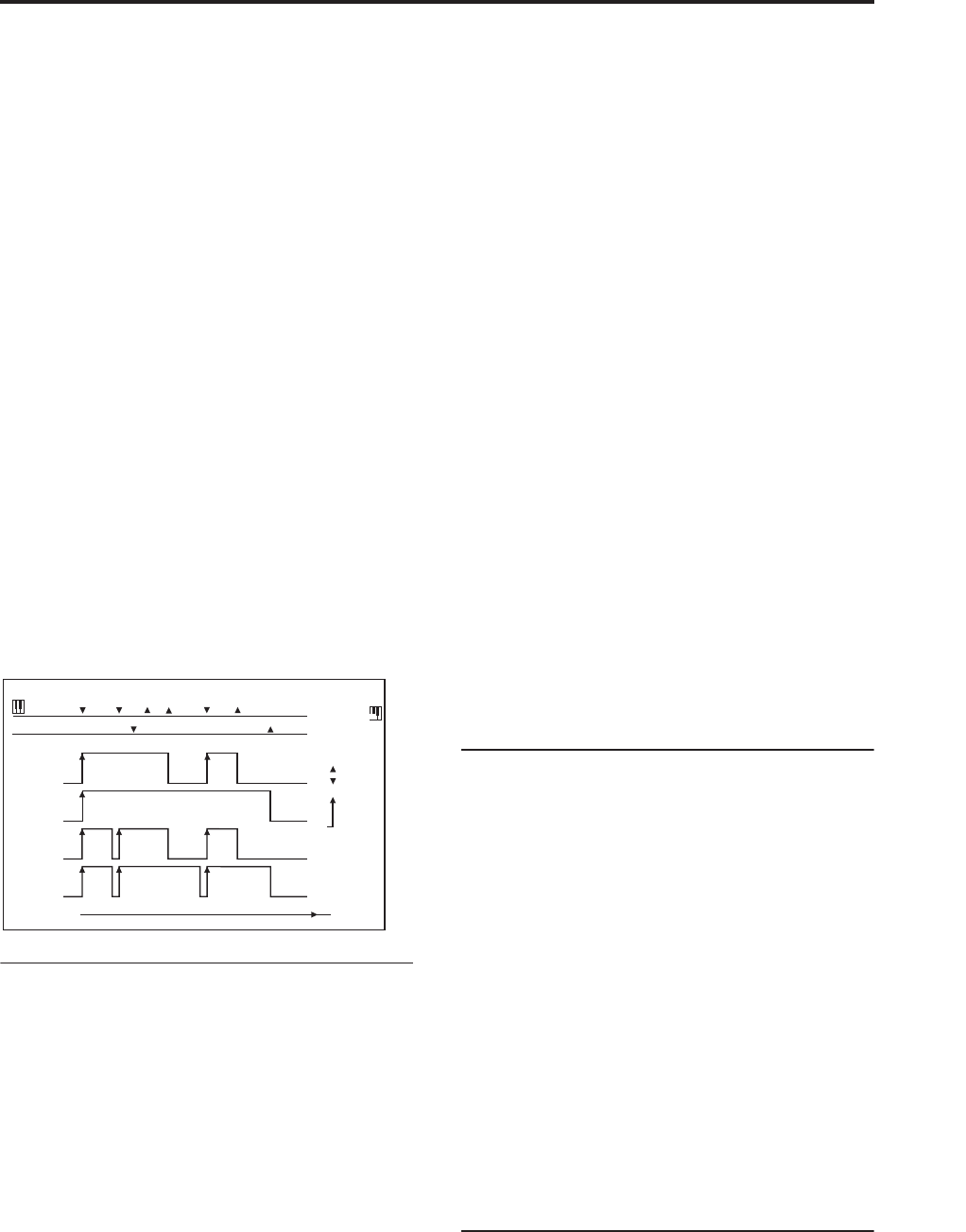
Alternate Modulation Sources (AMS) AMS (Alternate Modulation Source) List
969
Tempo
This lets you use the system tempo as a modulation
source. 120 is the center, for a value of 0; 60BPM is -99,
and 240BPM is +99.
Note that this is different from actually syncing to
tempo; for that purpose, use the dedicated
synchronization functions for the LFOs, effects, etc.
Gate1 and Gate1+Damper
Gate 1 is triggered by a new note after all notes have
been released, such as at the beginning of a phrase.
Gate 1+Damper is similar, except that it is triggered by
a new note-on after all notes and the damper are
released.
You can use this to reset the Common LFO and
Common Step Sequencer. For instance, to create an
effect similar to the per-voice LFO and Step
Sequencer’s Key Sync Off setting, use Gate 1 +
Damper as the reset source.
Gate2 and Gate2+Damper
Gate 2 is similar to Gate 1, but it triggers with every
new note-on, even in the middle of a legato phrase.
Gate2+Damper includes the damper pedal in the
equation, as shown in the diagram below.
Note: When used as a reset controller for Common LFO
and Common Step Sequencer, Gate2 and
Gate2+Damper will have the same effect.
HD-1
The HD-1 supports all of the “Physical and MIDI
controllers,” as described on page 967, in addition to
the AMS sources below.
AMS Mixer1&2
These are the outputs of the oscillator’s AMS Mixers.
For more information, see “6–1: OSC 1 AMS Mixer” on
page 89.
Wave Seq AMS Out1&2
These are the modulation outputs of the oscillator’s
Wave Sequence. For more information, see
“Modulating Program parameters per step” on
page 153 of the Operation Guide.
Pitch EG
This is the output of the Pitch EG, which is shared
between both oscillators. For more information, see “2–
9: Pitch EG” on page 56.
Filter EG
This is the output of the oscillator’s Filter EG. For more
information, see “3–4: Filter1 EG” on page 68.
Amp EG
This is the output of the oscillator’s Amp EG. For more
information, see “4–3: Amp1 EG” on page 78.
LFO1 &2
These are the outputs of the oscillator’s two LFOs. For
more information, see “5–1: OSC1 LFO1” on page 83.
Common LFO
This is the output of the Common LFO, which is
shared by all voices of both oscillators. For more
information, see “5–9: Common LFO” on page 87.
Filter Key Track
This is the output of the oscillator’s Filter Key Track
generator. For more information, see “3–2: Filter1
Modulation” on page 63.
Amp Key Track
This is the output of the oscillator’s Amp Key Track
generator. For more information, see “4–2: Amp1
Modulation” on page 75.
Common Key Track1&2
These are the outputs of the two Common Key Track
generators, which are shared between both oscillators.
For more information, see “6–9: Common Keyboard
Track” on page 95.
EXi Common
EXi programs support all of the “Physical and MIDI
controllers,” as described on page 967, in addition to
the AMS sources below, plus any AMS sources
provided by the specific EXi instruments.
Common Step Seq
This is the output of the Common Step Sequencer,
which is shared by all voices of both EXi. For more
information, see “5–1: Common Step Seq” on page 165.
Common LFO
This is the output of the Common LFO, which is
shared by all voices of both EXi. For more information,
see “5–2: Common LFO” on page 167.
Common Key Track1&2
These are the outputs of the two Common Key Track
generators, which are shared between both EXi. For
more information, see “5–2: Common LFO” on
page 167.
EXi AL-1
The AL-1 supports all of the “EXi Common” AMS
sources, in addition to the AMS sources below.
AMS Mixer1&2
These are the outputs of the two AMS Mixers. For
more information, see “6–1: OSC 1 AMS Mixer” on
page 89.
Gate1,Gate1+Damper,
Gate2,Gate2+Damper
Dmpr
Gate2
Gate2+Dmpr
Time
Gate1
Note
1
2
3
1
2
3
Damper Pedal
Gate1+Dmpr
On
Off
Reset
Controller


















